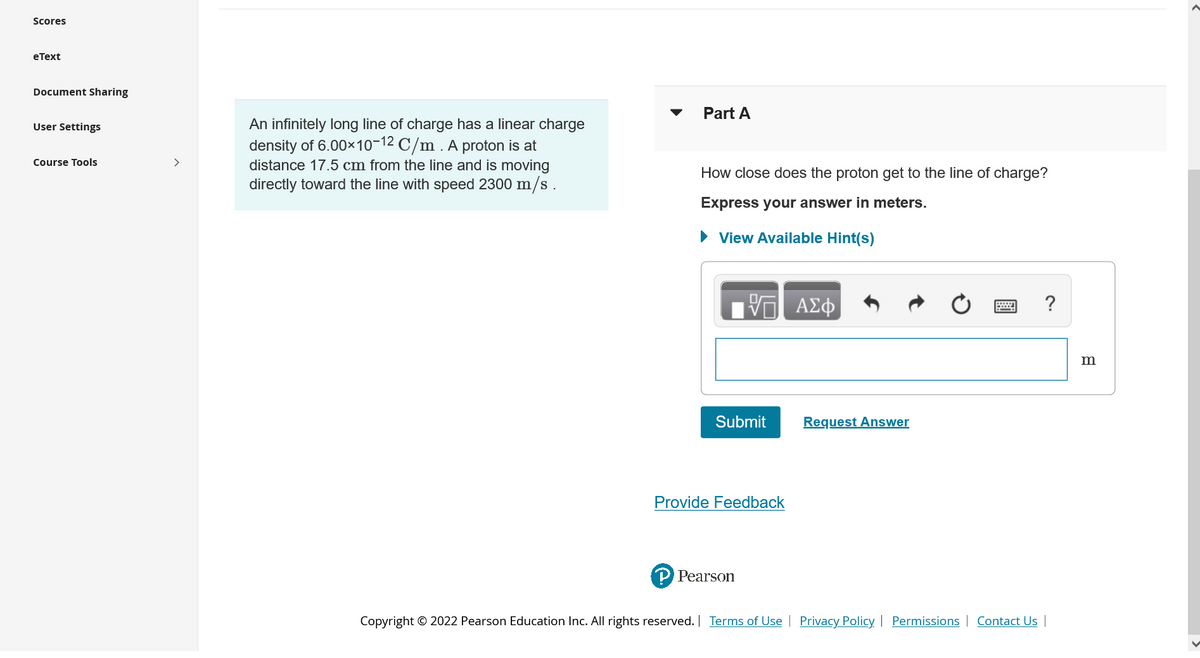An infinitely long line of charge has a linear charge density of 6.00×10−12 C/m . A proton is at distance 17.5 cm from the line and is moving directly toward the line with speed 2300 m/s . How close does the proton get to the line of charge?
An infinitely long line of charge has a linear charge density of 6.00×10−12 C/m . A proton is at distance 17.5 cm from the line and is moving directly toward the line with speed 2300 m/s . How close does the proton get to the line of charge?
Physics for Scientists and Engineers, Technology Update (No access codes included)
9th Edition
ISBN:9781305116399
Author:Raymond A. Serway, John W. Jewett
Publisher:Raymond A. Serway, John W. Jewett
Chapter25: Electric Potential
Section: Chapter Questions
Problem 25.3CQ: When charged particles are separated by an infinite distance, the electric potential energy of the...
Related questions
Question
An infinitely long line of charge has a linear charge density of 6.00×10−12 C/m . A proton is at distance 17.5 cm from the line and is moving directly toward the line with speed 2300 m/s .
How close does the proton get to the line of charge?

Transcribed Image Text:Scores
eText
Document Sharing
Part A
An infinitely long line of charge has a linear charge
density of 6.00x10-12 C/m . A proton is at
distance 17.5 cm from the line and is moving
directly toward the line with speed 2300 m/s.
User Settings
Course Tools
>
How close does the proton get to the line of charge?
Express your answer in meters.
• View Available Hint(s)
ΑΣφ
?
m
Submit
Request Answer
Provide Feedback
P Pearson
Copyright © 2022 Pearson Education Inc. All rights reserved. Terms of Use | Privacy Policy | Permissions | Contact Us |
Expert Solution
This question has been solved!
Explore an expertly crafted, step-by-step solution for a thorough understanding of key concepts.
This is a popular solution!
Trending now
This is a popular solution!
Step by step
Solved in 3 steps with 2 images

Knowledge Booster
Learn more about
Need a deep-dive on the concept behind this application? Look no further. Learn more about this topic, physics and related others by exploring similar questions and additional content below.Recommended textbooks for you

Physics for Scientists and Engineers, Technology …
Physics
ISBN:
9781305116399
Author:
Raymond A. Serway, John W. Jewett
Publisher:
Cengage Learning

Principles of Physics: A Calculus-Based Text
Physics
ISBN:
9781133104261
Author:
Raymond A. Serway, John W. Jewett
Publisher:
Cengage Learning


Physics for Scientists and Engineers, Technology …
Physics
ISBN:
9781305116399
Author:
Raymond A. Serway, John W. Jewett
Publisher:
Cengage Learning

Principles of Physics: A Calculus-Based Text
Physics
ISBN:
9781133104261
Author:
Raymond A. Serway, John W. Jewett
Publisher:
Cengage Learning


College Physics
Physics
ISBN:
9781305952300
Author:
Raymond A. Serway, Chris Vuille
Publisher:
Cengage Learning

College Physics
Physics
ISBN:
9781285737027
Author:
Raymond A. Serway, Chris Vuille
Publisher:
Cengage Learning

Physics for Scientists and Engineers
Physics
ISBN:
9781337553278
Author:
Raymond A. Serway, John W. Jewett
Publisher:
Cengage Learning